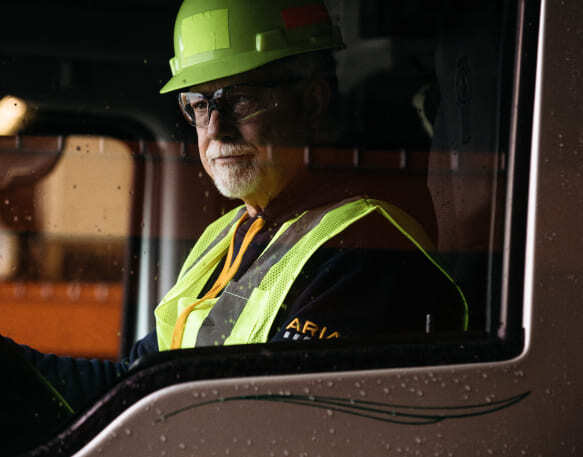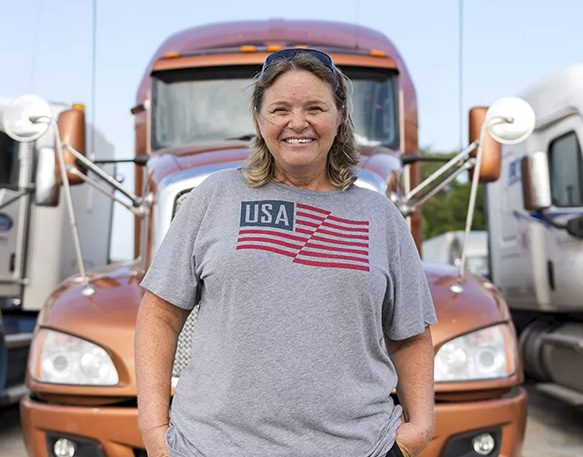Being an owner-operator can be a gratifying experience — after all, working for yourself and running your own business offers truckers many opportunities to grow.
One such opportunity for branching out and finding work as an owner-operator is to be contracted by a trucking company. The process is fairly straightforward on the surface. It involves you, the driver, signing an owner-operator lease agreement and providing support to a company’s existing fleet. But what exactly does it mean to be an owner-operator leased to a company, and what does a lease agreement entail?
In this article, we’ll go over what an owner-operator lease agreement is, the different types of arrangements you may encounter, and additional ways you can continue to grow your owner-operator business beyond leasing with a carrier.
What is an owner-operator lease agreement?
Trucking companies that want to add additional drivers to their fleet without directly hiring new employees may contract an owner-operator using an owner-operator lease agreement. This is a legal document that details the terms and conditions of the arrangement. Because an owner-operator is providing their services without technically being employed by the company, these agreements help to protect both parties involved and outline the nature of the relationship.
In an owner-operator lease agreement, the driver is essentially an independent contractor, providing for-hire services to an outside company and getting paid in return. Depending on the terms agreed to in the lease agreement, once the job is complete, the driver may have the chance to purchase the rig they used or they may have potentially made payments to buy the rig outright throughout the course of the agreement. But that’s getting ahead of ourselves since those are not the only options that owner-operators have following the completion of their contract.
What are the types of lease agreements
When it comes to a lease agreement, for trucking company owners to temporarily use the services of a driver, the terms of their relationship must be outlined by the company in an owner-operator lease agreement. There are a few different types of lease agreements, and understanding what each entails can help both owner-operators and carriers make the most out of this temporary partnership.
The three most common lease agreements are the lease program, lease-purchase, and lease on owner-operator. Let’s cover each of these more in-depth:
Lease program
Much like you would lease a car, the lease program agreement gives independent drivers who may not currently own a truck the opportunity to rent one out from the trucking company. This type of agreement is an excellent chance for owner-operators to get some experience on the road if they don’t yet have access to their own equipment. The owner-operator makes a monthly payment to the carrier throughout the lease program for the use of the truck. At the end of the lease, the company has the option to renew the lease or to lease a different truck to the owner-operator if they so desire.
With a lease program, purchase at the end of the lease is not required. However, there may be other stipulations to be aware of, such as credit requirements or down payments.
Lease-to-purchase
Lease-to-purchase, also sometimes referred to as a lease-to-own agreement, is similar to the lease program, where you make a monthly payment to a trucking company while they lend you a truck to use throughout your contract. However, at the end of your agreement, you will have the option to purchase the truck. This type of agreement is a great path for new owner-operators who may not have the money to buy their own truck outright, but want to build their network and experience by taking on jobs.
One major point to keep in mind with the lease-to-purchase agreement is that, more often than not, the owner-operator is responsible for covering the cost of repairs and maintenance on the vehicle. If you’re leasing an older truck, the likelihood of necessary care may be higher than if you’re leasing a newer rig.
Lease-on
The lease-on or leased-on owner-operator agreement is perfect for drivers that already have a truck of their own but may want assistance looking for freight. In this type of agreement, you already have ownership of your equipment and lease it to a trucking company to use.
In an owner-operator leased to company agreement, the driver will provide the truck and the services on behalf of the carrier company. When drivers are leased on, owner-operators have the added benefit of the trucking company handling certain aspects of the job. This includes taking care of freight dispatching and completing any necessary paperwork.
What are the key components of an agreement
Because leased-on owner-operators are not technically employees of the companies they’re contracted with, a lease agreement must cover specific regulations and address any potential concerns that may arise during the duration of the relationship to protect all parties involved. These regulations, often referred to as “truth in leasing” regulations, are determined by the FMCSA and are outlined under section 376 in the Code of Federal Regulation guidelines. These dictate how a carrier prepares their owner-operator lease agreement. A failure to create a document including these regulations will result in a fine or other penalties.
Many of the regulations cover relatively standard information, but their purpose is to ensure that all bases are covered and that everyone involved understands the terms of the agreement. Some of the most important of these regulations are:
Parties
The agreement must contain the name of the owner-operator, the trucking company, and anyone else involved in the contract. Then all parties must sign, acknowledging that they understand who is participating and what each party is responsible for.
Duration
This is another basic, but necessary, requirement. The lease agreement must list both the start and end dates of the contract. If there are any extensions, these must be included as well.
Equipment
Any piece of equipment that is to be used during the lease agreement must be listed. This includes everything from the truck itself to lift gates and dollies. It is also important to include who is responsible for providing said equipment, whether it’s the carrier company or the owner-operator.
Termination
Should any issues arise during the lease term, this section outlines the termination procedures and how to end the contract appropriately. In some cases, a carrier’s name may be removed entirely from the agreement upon termination.
Control
An agreement must explicitly state that the trucking company has control and exclusive possession of the owner-operator and their equipment while the lease is in effect. This is to ensure that the driver understands that they must comply with the carrier’s requests and abide by any rules designated by the company.
Compensation
There are a variety of ways a company may pay a driver for using their services, equipment, or both. The FMCSA has designated rules of payment, and it’s crucial that these compensation methods are detailed in the lease agreement. It’s important that the owner-operator lease agreement:
- Explicitly state how the carrier will pay the owner-operator. For example, payments can be based on a percentage of revenue or how many trips are completed. This section should also include the rate of payment.
- Must include a mention of the owner-operator’s “right to inspect” any carrier billing documents in cases where payment is based on a percentage of revenue.
- Mention that carriers must make payments to the owner-operator no later than 15 days beyond proof of delivery.
- Address the fact that if any damages occur to the cargo or other property, the agreement must state what deductions will apply to the driver.
- Designate which party is responsible for insurance coverage.
Grow your Business with DAT Freight & Analytics
Beyond becoming a leased-on driver for a trucking company, owner-operators have many ways to enhance their operations and grow their business. For those seeking the best way to expand their company, DAT Freight & Analytics has the tools, services, and experts to guide you toward success.
Best freight solutions for leased-on owner-operators
Leased-on owner-operators get their loads from a carrier, but there are still plenty of other solutions that owner-operators need to maximize efficiency on the road and become one of the best performing truckers on your carrier fleet. Luckily for leased-on owner-operators, the DAT One mobile app is your one-stop shop for all things trucking! When you’re on the road, there’s a lot more to hauling loads than just getting from point A to point B. DAT One’s trip-planning tools, such as locating truck stops and weigh stations, finding nearby parking, or viewing market data like fuel prices, are all essential features that make your trip run smoothly. Some other DAT solutions that can aid leased-on owner-operators include:
DAT Trendlines
If you want to ensure you’re securing the best rates for your freight, DAT Trendlines is a trusted, up-to-date resource for truckload pricing. Get weekly snapshots of freight rates for a variety of truck types and for different lanes throughout the country. And for owner-operators who want to take it a step deeper, RateView Analytics gives detailed insights into any lane, helps forecast seasonal trends, and uses industry-standard information to protect and grow your bottom line.
Freight factoring services
Owner-operators have a lot of responsibilities to juggle, including managing cash flow. One of the most important aspects of a business is getting paid. Freight factoring makes that process much simpler. With Outgo, DAT’s freight factoring solution, businesses both big and small can skip long wait times and get paid in just a few hours. Outgo offers transparent pricing, no hidden fees, and full invoice management — all integrated directly within the DAT One app you already use to find loads.
Quickly find loads with the DAT load board!
Finding loads is no longer a lengthy, tedious process that involves papering flyers or calling up every broker or shipper in the area. Instead, you can use the DAT load board to find the perfect match.




